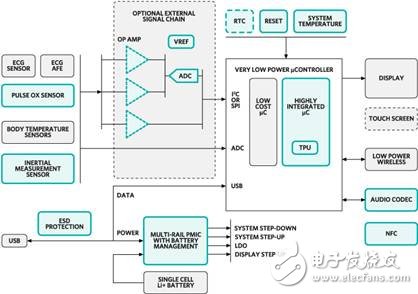Advances in semiconductor technology have made it possible to wear lightweight, small-sized wearable ultra-low-power battery-powered embedded systems. These systems typically have powerful ultra-low-power microcontrollers that connect a very complex set of sensors while communicating through a low-power RF link to an external system. The combination of powerful ultra-low-power microcontrollers, ultra-low-power analog body signal sensors and innovative power supplies and battery management circuits is driving the growth of the wearable healthcare market.
Wearable medical devices monitor body signals for many years and provide physicians with useful health diagnostic information. The same monitoring equipment has also been applied to high-performance sports applications to help optimize body functions. Wearable body signal monitoring products now offer the same type of information to users in the health and function optimization market at a lower price.
For health sensing and monitoring, signals that are typically monitored in a clinical setting are almost always available through wearable products. These traditional signals include :
Pulse/heart rate
Blood oxygen
pressure
Electrocardiogram (EKG/ECG)
body temperature
Ultraviolet (skin exposure)

Figure 1 Block diagram of the wearable healthcare monitoring platform
Wearable Healthcare Monitoring Platform SystemThis system is implemented by high performance, complex integrated circuits. The power of the IC in the system has been optimized to provide body signal monitoring using a compact, lightweight rechargeable lithium-ion battery or a replaceable, non-rechargeable button battery.
While the main features of many products are implemented through firmware algorithms, physical design provides a platform to carry these features. Once the platform is developed, it can be reused for a variety of different products.
Power and battery managementPower is a very important aspect of any wearable healthcare platform. These products must be small and not invasive, so a very small and lightweight battery must be used. The available charge of the battery and the power consumption characteristics of the platform determine the availability of the product. It is often desirable for any wearable product to work for at least one day before it needs to be recharged. Products that use non-rechargeable batteries should have a battery life of several months.
For devices with rechargeable batteries, the battery management system must include a battery charger and a battery fuel gauge. The battery management system must allow the device to operate while charging.
Since the battery is a voltage source with a decreasing voltage output, the power supply system must be able to regulate the battery voltage. The efficiency of the regulator must be high in order to maximize charge utilization and must also provide the number of tracks required for the design. The available voltage range for rechargeable lithium batteries is 4.2V~3.2V. Most wearable products use a main power rail that is lower than the lowest charge of a single-cell lithium battery, so the main rail in a wearable design comes from a buck regulator. Some features in wearable products may require voltage levels higher than those provided by a single battery. In order to provide these voltage levels, the power management function must have at least one boost regulator. The number of power rails required depends on the capabilities of the device, but for optimum efficiency, it needs to minimize the number of power rails required.
processorPower consumption and processing power are the most important determinants when choosing a microcontroller for this application. A system partitioning strategy should be used to determine which system functions are best integrated into the microcontroller and which can be handled externally. Because wearable health devices read body signals, the functionality of any on-chip data analog circuitry is also taken into account to ensure they accurately handle low-level body signals.
For microcontrollers, there are two general low-power strategies available:
A microcontroller includes all or most of the precision analog circuitry required;
Another low-cost microcontroller does not have sophisticated analog capabilities.
If a lower cost microcontroller is selected, the precision signal conversion must be performed on an external signal processing chain to digitally input the sensor signal into the microcontroller. Ultra-small, high-precision, low-power analog circuitry can be used to support this option.
The most commonly used microcontrollers for wearable applications use an ARM architecture optimized for low power consumption. Depending on the processing requirements of the device, the processor will be between 16 and 32 bits. The processor will integrate multiple power modes, and the system software will have programmable shutdown and sensor-based wake-up.
Sensor and sensor interfaceMany sensors can be used to monitor body signals within a wearable device. Sensor technology for acquiring body signals has been around for many years, but until recently it was only possible to use sensors to provide good signals without consuming a lot of power.
Sensor technology can be used to measure :
Blood oxygen
Heart rate
ECG/EKG
pressure
temperature
The electrical output from these sensors is very small, in the millivolt range. However, many of these common sensors have integrated amplification and conversion circuitry in a single package so that they can output more advanced analog signals or serialized digital signals. The interface circuits of these sensors are designed for ultra low power operation.
As for the ECG sensor, these are essentially physical skin contacts, collecting very small electric fields around the skin area and transmitting signals to the EKG signal chain. The low-cost wearable ECG is limited to 2 to 3 touch points and does not provide the resolution of a cost-effective professional ECG/EKG system with 9 to 11 sensors scattered throughout the body and attached to strategic points.
CommunicationModern wearable devices typically provide a micro USB port for mass data transfer, firmware update, and battery charging. In addition, many wearable health products use low-power wireless transceivers to send and receive data in real time while the device is in use. Wireless transmission allows data to be transferred to a larger display or remote data acquisition device. Bluetooth low energy is an emerging standard for this purpose. In addition, NFC (Near Field Communication) provides a limited range of wireless connections, ideal for short content transfers such as configuration information and recorded data retrieval.
The Maxim MAX66242 Secure RFID Tag authenticates the user and accepts only communications from authenticated sources via NFC.
User interfaceThe user interface of the wearable product will vary depending on the desired functionality. Low-power design is critical, so the display size is minimized. Depending on the product, the user interface will include a single line LCD display with several control buttons. Products that need more information will have a low-power TFT display that is likely to include touch screen functionality.
Since processing power has become so cheap and powerful, many wearable devices may end up with a voice command interface.
Main componentsHealth Measurement Microcontroller MAX32600
The MAX32600 microcontroller is based on the industry-standard ARM Cortex-M3 32-bit RISC CPU operating at up to 24MHz. It contains 256KB of flash, 32KB of SRAM, a 2KB instruction cache, and an integrated high-performance analog peripheral.
The MAX32600 is available in 192-bump 12mm & TImes; 12mm CTBGA 120 solder balls 7mm & TImes; 7mm CTBGA and 108-bump WLP packages.
In addition to Maxim's free tools, the MAX32600 also supports IAR's embedded Workbench. IAR Embedded Workbench integrates one compiler, one assembler, one connector and one debugger in one IDE. It is easy to use, provides advanced, high-efficiency optimization, and is highly integrated with hardware, RTOS products, and middleware. The IAR Embedded Workbench for ARM is available in several versions, including a product suite specifically for the ARM Cortex-M core family.
The multi-speed air supply mode can bring you a comfortable and cool breeze in various scenarios. The 180° wide-angle surrounds the healthy and refreshing natural wind, and the soft wind blows on the face, returning to the natural and refreshing. The fuselage is equipped with a lanyard, so you can take the wind with you anytime anywhere.
Neck Fan,Small Fan,Portable Mini Fan,Hanging Neck Fan
Dongguan Yuhua Electronic Plastic Technology Co.,Ltd , https://www.yuhuaportablefan.com
